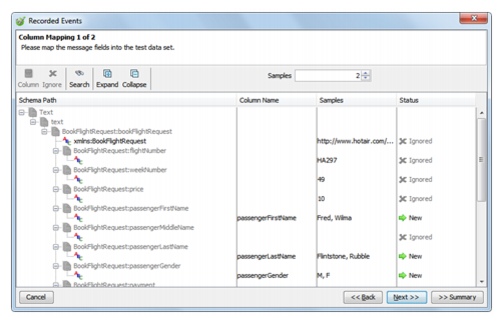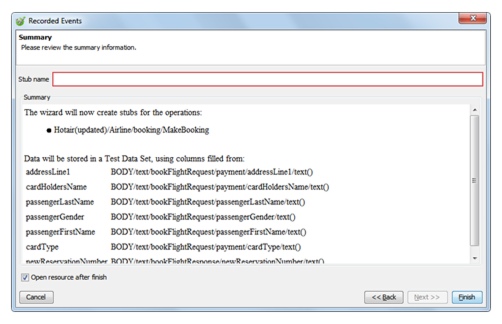A data-driven stub is a stub that is driven by the contents
of a data source.
About this task
The data fields that have been promoted
to the events table (for information about this, refer to Rational Integration Tester reference)
are used to create the data source.
The following
table outlines the different types of data sources that IBM Rational Integration Tester supports.
(For more information about these data source-types, refer to Rational Integration Tester reference.)
| Data Source-Type |
Produced by Recorded Events Wizard? |
Description |
|---|
| File data source |
Yes |
This reads data from a file, for example, a comma-separated
value (CSV) file, a fixed width file, or some other delimited file-type. This data can be supplied to any tests or stubs in Rational Integration Tester.
|
| Excel data source |
No |
This reads data from a worksheet in a Microsoft Excel workbook file. |
| Database data source |
No |
This reads data from a table in a database or the results of
a query on a database. Note: The database must be set
up in Rational Integration Tester’s
Architecture School perspective before this data source can be created.
|
| Directory data source |
No |
This reads in a set of files, for example, a set of XML documents. |
You can create a data-driven stub from recorded
events or you can create a data source for a driven stub without using
recorded events.
For example, you could create
a stub by using the associated operation’s Message Exchange Pattern
properties (for information about this, refer to Message exchange pattern (MEP) method) and then modifying
the stub to read information from an Excel workbook file (with or
without repeating elements), look up specified data, and then send
any matching data in reply messages (for information about this, refer
to Modifying message-based stubs).
To create a data-driven stub from recorded events:
- In Rational Integration Tester’s
Recording Studio perspective, select multiple recorded events on the
Events View window.
Note: For
information about using the Events View window, including searching
recorded events, see
Managing the Events view.
- Click the arrow button
(
 ) next to the Save Stub from selected events button
(
) next to the Save Stub from selected events button
( ) on the Events View toolbar and then click Save
Parameterized Stub on the shortcut menu.
) on the Events View toolbar and then click Save
Parameterized Stub on the shortcut menu. Alternatively, right-click the messages and click Save
Parameterized Stub on the shortcut menu.
The Operation Assignment screen of the Recorded Events
wizard is displayed.
The Operation Assignment
screen, which is the third screen of the wizard, enables you to modify
(if you want) the operation and the events associated with the stub.
Note: The first and second screens of the Recorded Events
wizard are the Resource Type and Data Storage screens. The screens
are displayed only if you click the
Save button
(

) or press CTRL+S. Clicking the
Save Stub from selected
events button (

) bypasses
the Resource Type and Data Storage screens.
For
information about using Operation Assignment screen, refer to Creating basic stubs.
Note: If you are creating a stub for multiple operations, Rational Integration Tester will
attempt to verity that all selected recorded events are associated
with the correct operations.
- Clicking Next on
the Operation Assignment screen displays the Transaction Assignment
screen.
The Transaction Assignment screen,
which is the fourth screen of the Recorded Events, enables you to
group events into transactions.
Note: The groups
that you choose are important because they will determine the number
of merged messages and thus the number of remaining screens in the
Recorded Events wizard. For example, one recorded event may have a
single transaction, which means that there is only one mapping. Alternatively,
two recorded events may be grouped into two groups, which means that
there are two transactions and thus only one mapping. Equally, two
recorded events may be put into a single group, which means that there
are two mappings.
For information about using
Transaction Assignment screen, refer to Creating basic stubs.
- Clicking Next on
the Transaction Assignment screen displays the Column Mapping screen.
The Column Mapping screen enables you to map
the fields in the selected recorded events to the data source that
will be used for data-driven stubbing.
The following table describes
how to use the Column Mapping screen.
| To... |
Do this... |
|---|
| Specify that a field in a recorded event will be a column in
the data source |
1. Select the field. 2. Click Column.
The Map to column dialog box is displayed.
3.
Click OK. For the selected field, New is
displayed under Status.
|
| Map a field in a recorded event to an existing column |
1. Select the field. 2. Click Column.
The Map to column dialog box is displayed.
3.
In the list, click the column name to which you want to map the field.
4. Click OK.
|
| Specify that a field in a recorded event is not mapped |
1. Select the field. 2. Click Ignore.
|
| Search for a specific data item in a recorded event |
1. Click Search. 2.
In the Find field (displayed on the lower half of the screen),
enter your search query.
3. Press ENTER.
|
| Increase or decrease the number of example values displayed
for each field |
In the Samples box, enter or select the number of examples
you want to display (default value: 2). |
| Expand or collapse a node |
1. Click the node. 2. Click Expand or Collapse (as
applicable).
|
| Close the wizard without making any changes |
Click Cancel. |
| Move to the (previous) Transaction Assignment screen |
Click Back. |
| Move to the next screen |
Click Next. Note: Another
Column Mapping screen might display. The number of Column Mapping
screens displayed by the Recorded Events wizard depends on the number
of merged messages (which is determined by settings in the Transaction
Assignment screen).
|
| Move to the (final) Summary screen of the wizard |
Click Summary. |
The Summary screen, which is the final
screen of the Recorded Events wizard, enables you to review the configuration
of the stub and to save the stub.
For information about
using the Summary screen, refer to Creating basic stubs.
Results
After clicking Finish on
the Summary screen:
- Rational Integration Tester’s
Test Factory perspective is displayed, and the newly created stub
and data source are displayed under the relevant logical resource
on the Test Factory perspective’s component tree. If you created a
stub for multiple operations, the stub is displayed under each applicable
operation.
- If you selected the Open resource after finish check
box on the Summary screen, the stub is also opened in the Stub Editor
(for information about this, refer to Modifying message-based stubs). A Lookup
Test Data action that uses the new data source is displayed on the Business
Logic tab on the Events tab of
the Stub Editor.
Note: The Output tab may
not detect a Send Reply action on the Business Logic tab
if the Send Reply action is nested under a Lookup Test Data action.

